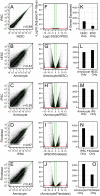Genome-wide analysis reveals the unique stem cell identity of human amniocytes
- PMID: 23326421
- PMCID: PMC3542377
- DOI: 10.1371/journal.pone.0053372
Genome-wide analysis reveals the unique stem cell identity of human amniocytes
Abstract
Human amniotic fluid contains cells that potentially have important stem cell characteristics, yet the programs controlling their developmental potency are unclear. Here, we provide evidence that amniocytes derived from multiple patients are marked by heterogeneity and variability in expression levels of pluripotency markers. Clonal analysis from multiple patients indicates that amniocytes have large pools of self-renewing cells that have an inherent property to give rise to a distinct amniocyte phenotype with a heterogeneity of pluripotent markers. Significant to their therapeutic potential, genome-wide profiles are distinct at different gestational ages and times in culture, but do not differ between genders. Based on hierarchical clustering and differential expression analyses of the entire transcriptome, amniocytes express canonical regulators associated with pluripotency and stem cell repression. Their profiles are distinct from human embryonic stem cells (ESCs), induced-pluripotent stem cells (iPSCs), and newborn foreskin fibroblasts. Amniocytes have a complex molecular signature, coexpressing trophoblastic, ectodermal, mesodermal, and endodermal cell-type-specific regulators. In contrast to the current view of the ground state of stem cells, ESCs and iPSCs also express high levels of a wide range of cell-type-specific regulators. The coexpression of multilineage differentiation markers combined with the strong expression of a subset of ES cell repressors in amniocytes suggests that these cells have a distinct phenotype that is unlike any other known cell-type or lineage.
Conflict of interest statement
Figures







Similar articles
-
A plethora of human pluripotent stem cells.Cell Biol Int. 2013 Sep;37(9):875-87. doi: 10.1002/cbin.10120. Epub 2013 May 23. Cell Biol Int. 2013. PMID: 23619972 Review.
-
Comparative analysis of the retinal potential of embryonic stem cells and amniotic fluid-derived stem cells.Stem Cells Dev. 2011 May;20(5):851-63. doi: 10.1089/scd.2010.0291. Epub 2010 Dec 6. Stem Cells Dev. 2011. PMID: 20939691
-
A genome-wide RNAi screen reveals determinants of human embryonic stem cell identity.Nature. 2010 Nov 11;468(7321):316-20. doi: 10.1038/nature09531. Epub 2010 Oct 17. Nature. 2010. PMID: 20953172
-
Amniocytes can serve a dual function as a source of iPS cells and feeder layers.Hum Mol Genet. 2011 Mar 1;20(5):962-74. doi: 10.1093/hmg/ddq542. Epub 2010 Dec 14. Hum Mol Genet. 2011. PMID: 21156717 Free PMC article.
-
Does transcription factor induced pluripotency accurately mimic embryo derived pluripotency?Curr Opin Genet Dev. 2012 Oct;22(5):429-34. doi: 10.1016/j.gde.2012.07.003. Epub 2012 Oct 15. Curr Opin Genet Dev. 2012. PMID: 23079387 Free PMC article. Review.
Cited by
-
Improving gene isoform quantification with miniQuant.Nat Biotechnol. 2025 Jun 3:10.1038/s41587-025-02633-9. doi: 10.1038/s41587-025-02633-9. Online ahead of print. Nat Biotechnol. 2025. PMID: 40461779 Free PMC article.
-
The stem cell marker Prom1 promotes axon regeneration by down-regulating cholesterol synthesis via Smad signaling.Proc Natl Acad Sci U S A. 2020 Jul 7;117(27):15955-15966. doi: 10.1073/pnas.1920829117. Epub 2020 Jun 17. Proc Natl Acad Sci U S A. 2020. PMID: 32554499 Free PMC article.
-
Functional analysis of limb transcriptional enhancers in the mouse.Evol Dev. 2014 Jul-Aug;16(4):207-23. doi: 10.1111/ede.12084. Epub 2014 Jun 11. Evol Dev. 2014. PMID: 24920384 Free PMC article.
-
Pharmacological exposures may precipitate craniosynostosis through targeted stem cell depletion.Stem Cell Res. 2019 Oct;40:101528. doi: 10.1016/j.scr.2019.101528. Epub 2019 Aug 6. Stem Cell Res. 2019. PMID: 31415959 Free PMC article.
-
Amniotic fluid stem cells inhibit the progression of bleomycin-induced pulmonary fibrosis via CCL2 modulation in bronchoalveolar lavage.PLoS One. 2013 Aug 13;8(8):e71679. doi: 10.1371/journal.pone.0071679. eCollection 2013. PLoS One. 2013. PMID: 23967234 Free PMC article.
References
-
- De Santis M, De Luca C, Mappa I, Cesari E, Quattrocchi T, et al. (2011) In-utero stem cell transplantation: clinical use and therapeutic potential. Minerva Ginecol 63: 387–98. - PubMed
-
- Fauza D (2004) Amniotic fluid and placental stem cells. Best Practice & Research Clinical Obstetrics & Gynaecology 18: 877–91. - PubMed
-
- Shaw SW, David AL, De Coppi P (2011) Clinical applications of prenatal and postnatal therapy using stem cells retrieved from amniotic fluid. Curr Opin Obstet Gynecol 23: 109–16. - PubMed
-
- Antonucci I, Pantalone A, Tete S, Salini V, Borlongan CV, et al. (2012) Amniotic fluid stem cells: a promising therapeutic resource for cell-based regenerative therapy. Curr Pharm Des 18: 1846–63. - PubMed
Publication types
MeSH terms
Substances
Grants and funding
LinkOut - more resources
Full Text Sources
Other Literature Sources
Medical

